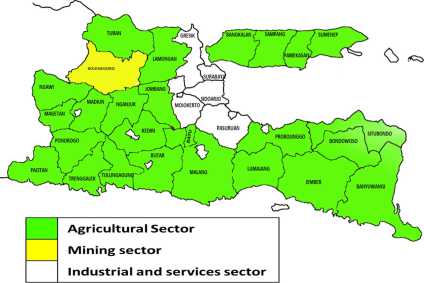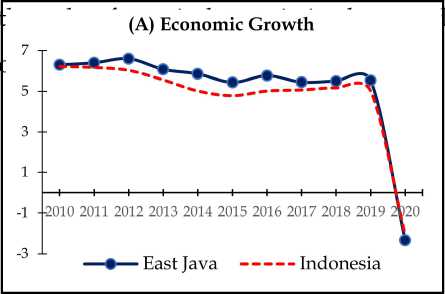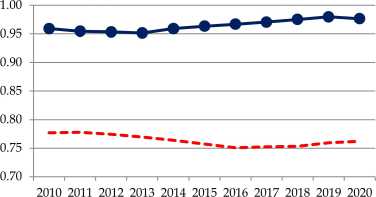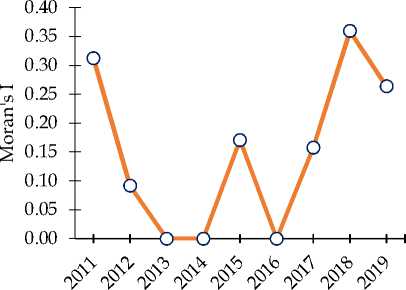Does Agroindustry Accelerate Convergence of Economic Growth in East Java?
on
pISSN : 2301 – 8968
JEKT ♦ 16 [1] : 1-9
eISSN : 2303 – 0186
Does Agroindustry Accelerate Convergence of Economic Growth in East Java?
Dwi Budi Santoso
ABSTRAK
Pada sebagian besar daerah di Jawa Timur, pembangunan ekonominya masih bertumpu pada sektor pertanian. Sementara itu, sejak 2008, agroindustry telah berkembang pesat di Jawa Timur. Kondisi ini seharusnya menyebabkan terjadinya percepatan pertumbuhan ekonomi dan juga percepatan perbaikan ketimpangan pembangunan antardaerah, atau percepatan perbaikan tingkat konvergensi. Namun, nampaknya tidak seperti itu, dimana tingkat ketimpangan pembangunan antardaerah di Jawa Timur masih jauh diatas Nasional. Oleh karena itu, studi ini bertujuan untuk mengestimasi seberapa besar peran agroindustry terhadap kecepatan perbaikan konvergensi di Jawa Timur. Selanjutnya, least square dan spatial model digunakan sebagai metode estimasi. Sedangkan model konvergensi Barro digunakan sebagai dasar model analisis. Data yang digunakan adalah data panel dari 38 daerah dengan periode waktu 2010 hingga 2019. Hasil estimasi menunjukan adanya peran pembangunan agroindustry terhadap percepatan perbaikan konvergensi, namun tidak terlalu besar. Salah satu penyebabnya adalah masih belum adanya spillover effect yang ditimbulkan dari adanya pembangunan agroindustri
Kata kunci: Model spasial, Agroindustri, Ketimpangan Output Antardaerah Klasifikasi JEL: C21, Q13, O47
ABSTRACT
In most areas of East Java, the economic development still relies on the agricultural sector. Meanwihle, since 2008, agroindustry has grown fast in East Java. This situation should have impact towards higher economic growth in lieu with lower regional development disparity, or speed of convergence improvment. However, the reality seems to be different, where the level of regional development inequality in East Java is still far above the National level. Thus, this study aims to estimate the magnitude of agroindustry in the acceleration of convergence in East Java. This study uses least squares and spatial models as estimation methods as well as the Barro convergence model as the basis of model analysis. The data used is panel data from 38 regions from 2010 to 2019. The estimation results show that agroindustry development has played a role in accelerating convergence improvement, but not too big. One reason is that there is still no spillover effect arising from agroindustry development.
Keywords: Spatial Model, Agroindustry, Cross-Region Output Convergence
JEL Classification: C01, Q13, O47
INTRODUCTION
Neoclassical school of thought believe that in the model of economic growth, poorer regions should grow faster than richer ones, namely convergence. Thus, it implies that the acceleration of economic growth should be in line with improving regional development disparities. However, the reality sometime is different, because accelerating the convergence level not only depends on economic growth but also depends on the speed of spillover, which can be done by reinforcing the linkages of inter-sectoral and interregional development (Ravallion, et al., 2022; Santoso, 2021).
The convergence rate in East Java should be higher than other regions in Indonesia. This is based on the facts shown in Figure 1, where agroindustry’s role in industrialization in East Java is huge and tends to increase, namely around 82% in 2010 to 84% in 2020. Meanwhile, most of the regional economic development in East Java is still based on the agricultural sector.
This condition should accelerate economic growth with a low level of regional development inequality. It is due to the strong linkages between
agroindustry and agricultural sector

(B) Regional Economic Base in EastJava

Source: BPS Indonesia and East Java
Figure 1. Industrialization and Regional Economic Base in East Java
However, the reality is just the opposite. Figure 2 indicates an accelerated economic growth rate in East Java accompanied by high regional
development inequality. Therefore, this study aims to estimate how significant

(B) Regional Inequality

—•— East Java ----- Indonesia
Source: BPS Indonesia and East Java
Figure 2. Growth and Regional Inequality Development in East Java
RESEARCH METHODS
The analytical model used in this study is the development of the convergence model from Barro (1992) with the following model specifications: G™p = β0 + β1ln yi,t0 + εi,t..........................(1)
The left side of equation (1) reflects the per capita growth of area (i) during (t) years. Meanwhile, the right side reflects
the relationship between regional economic growth (i) and per capita income in the base year (In yito). If the value of β1 is negative, it indicates convergence, i.e., affluent areas, where those with high per capita income will have lower economic growth than poorer areas. Conversely, divergence occurs when the value of β1 is positive. In simple terms, the value of β1 indicates the degree of convergence or divergence.
Furthermore, to estimate the impact of agroindustry (AIiito) on the regional inequality level and also its role in the growth of per capita income, equation (1) is developed into equation (2) which specifically becomes as follows:
G™p = β0 + β1ln yiιt0 + β2ln AIiih + εi, ^. (2)
The difference in the value magnitude of β1 in equations (1) and (2) indicates the accelerated improvement of convergence or divergence.
Meanwhile, to test whether there is a relationship between economic growth in one region and souranding regions, spatial econometrics is used,
namely modifying equation (1) to become the following equation:
Gc^ = p(W * Gcl^) + βo + βιlny + εif.. (3) Where (p') is the spatial lag coefficient that indicates the magnitude of a region’s income per capita growth effect on its neighbors, which is called the spillover effect (Arbia, 2006; Santoso, 2021).
In regard to equation (2), it is also necessary to test whether there is a spatial effect as means to discover the possibility of inter-regional linkages when agroindustry is taken into account. Hence, equation (2) is developed into the following equation: Gc°? =p(W*G^)+βa+β1lnyl,t0 +
β2ln AIiito+εi t.... (4)
Furtermore, Barro (1992) also provides a simple formula for estimating how many years it will take for the level of development inequality between regions to disappear or for convergence to be achieved. The calculation formula is as follows:
ln(2) ln(l+βl)
…. (5)
Where (τ) is the years needed to equalize the level of the inter-regional development.
RESULTS AND DISCUSSION
Estimation Result
Table 1 shows the estimation result for agroindustry impacts on convergence that occurs in economic development. Estimation result in Model 1 shows income per capita has negatively significant impact on income per capita growth in East Java. This suggests that the economic development in East Java is convergent. This further implies that poor areas, as measured by per capita income, tend to have higher economic growth than affluent region. Thus, the level of income per capita between poor and affluent region will become equal in the foreseen future. This refers to the improvement of regional development inequality or convergence.
Furthermore, the estimation results in Model 2 show that
agroindustry plays a role in accelerating convergence and regional economic growth. In Model 1, the convergence level was found to be 0.0176, which is lower than that in Model 2, which was 0.0278. Hence, agroindustry accelerates the improvement of convergence by 0.0102. Model 2 also shows that agroindustry accelerates economic growth around 0.00263.
However, agroindustry does not play a fundamental role in increasing inter-regional development linkages. It can be seen from the spatial coefficient
(ρ) estimation results, which are insignificant in either Model 3 or 4. It means that agroindustry development does not significantly increase the speed of spillover effect.
The role of agroindustry in accelerating convergence can still be increased. One method is by strengthening the linkage between the development of the agricultural sector and agroindustry, notably by expanding the use of raw materials from the surrounding area.
Table 1: Estimation Result for Agroindustry Impacts on Convergency
|
Independent Variables |
Dependent Variable: Growth of Income per capita Without Spillover Effects Use Spillover Effects (Spatial Considerations) Model 1 Model 2 Model 3 Model 4 |
|
Income per capita |
-0,0176*** -0.0278*** -0.0183249*** -0.0291021*** (0.00585) (0.00826) (0 .00555) (0 .0078215) |
|
Share of agroindustry |
0.00263* .0027453* - (0.00150) - (0 .001412) |
|
Spatial coefficient (p) |
-0.0500105 -0.0557531 (0.0644518) (0.0643023) |
|
Constant |
0.105*** -0.0806 (0.0187) (0.108) |
|
R2 Number of obs. |
0,029 0,039 0.0303 0.0412 380 380 380 380 |
Catatan: i) *** Sign. 1%, ** Sign. 5%, Sign. 10%.
ii) the numbers in brackets are the standard error.
Source: estimate result (2021)
Table 2 shows the results of the estimation of how long it will take to eliminate inter-regional development
inequalities in East Java. When calculations are only based on Model 1, inter-regional development disparities
will disappear after 39-40 years. Meanwhile, if agroindustry is included in the calculation (Model 2), the time needed to achieve convergence is
Table 2. Estimation of the Role of Agroindustry on Economic Growth and Regional Inequality
|
Information |
Estimated time needed to remove regional disparities (years) |
Estimated Revenue Growth per capita (%) | |
|
1 |
Without taking into account the role of the agroindustry |
39,0 up to 40,1 |
5,2 up to 5,8 |
|
2 |
Taking into account the role of the agroindustry |
34,6 up to 35,8 |
5,7 up to 6.0 |
Source: estimate
Discussion
Based on the estimation results above, it appears that agroindustry development relatively accelerates the occurrence of convergence in East Java. It is quite reasonable considering that agroindustry has an adequately close linkage with the agricultural sector, which is the base sector for the majority of regions in East Java. The development of the agroindustrial sector will provide added value to farmers as providers of agroindustrial raw materials.
The results in this study align with research conducted by Fatah (2007) and Baymul et.al (2020), where agroindustry
around 34-35 years. Thus the agroindustry accelerate convergence improvment just around 4-5 years.
result (2021) functions as a bridge for economic transformation, create job opportunities, accelerate rural development, prevent urbanization, and increase the poor’s income to ensure food security.
Thus, it can be concluded that agroindustry development is urgent to support the agenda of accelerating the improvement of development disparities inter-regions in East Java. Nonetheless, the role of agroindustry is still not as expected, where equitable regional economic development requires a relatively long time, around three decades.
According to Santacoloma et al., (2005), the phenomenon of the weak
role of agroindustry built in agricultural base areas is the complexity of the relationships formed in the agroindustry supply chain. Even on a broader scale, supply chain strengthening coordination forms are often not in favor of farmers. The emergence of more complicated contract designs and standards set by agroindustry makes farmers or farmer groups not have enough space to design or negotiate company contracts (Kirsten & Sartorius, 2002).
On the other hand, regional development inequality in East Java is still high, far above the National. It is because the level of inter-regional linkages of economic growth in East Java is still low, especially between industrial-based regions and agricultural-based regions. This argument is strengthened by the results of calculating the Moran correlation index. Figure 3 shows that the Moran’s-I value is still very low, below 0.5. Even in 2013, 2014 and 2016, Moran’s-I value was not significant.

Source: estimate result (2021)
Figure 3. Inter-Regional Growth Linkages in East Java
A low Moran’s-I indicates an
acceleration of economic growth in agroindustry areas which does not necessarily result in economic growth in the surrounding agricultural-based areas. This low level of linkages indicates less use of local raw materials by the agroindustry. It can be seen that many agroindustrial in East Java still import their raw material needs, even though their availability is abundant in local areas.
CONCLUSION
Based on the discussion above, agro-industrial development is a strategic sector to achieve inclusive economic growth in East Java. The development of agroindustry has great potential in increasing per capita income
growth and accelerating the improvement of inter-regional disparities. Nevertheless, the speed of convergence is low and it is predicted that the time needed to reach convergence is around thirty four to thirty five years.
Although industrialization is dominated by agroindustry,
development disparities between regions in East Java are still relatively
REFERENCE
Amalia, S. K., Santoso, D. B., & Sasongko, S. (2018). Convergence Analysis of Economic Growth in East Java. JEJAK, 11(1), 151–161. https://doi.org/10.15294/jejak.v11i 1.9643
Arbia, G. (2006). Economitric Spatial: Statistical Foundations and Applications to Regional Convergence. Springer
Barro, R. J. (1992). Convergence. Journal of Political Economy, 100(2), 223–251. https://doi.org/10.1086/261816
Baymul, C., & Sen, K. (2020). Was Kuznets Right? New Evidence on the Relationship between Structural Transformation and Inequality. The Journal of Development Studies, 56(9), 1643–1662.
https://doi.org/10.1080/00220388. 2019.1702161
high. This indicates the weak linkage of development between agroindustry and agricultural sectors. It can be identified from the import values of raw materials, which continues to increase. Therefore, strengthening the linkages between agricultural sector and agroindustry becomes main issue in formulating policy regarding agro-industrial development in the future.
Fatah, L. (2007). The Potentials of AgroIndustry for Growth Promotion and Equality Improvement in
Indonesia. Asian Journal of
Agriculture and Development, 3(1– 16).
https://doi.org/10.22004/ag.econ.1 65855
Grabowski, R. (2022). Agricultural productivity and the share of manufacturing employment. Canadian Journal of Development Studies / Revue Canadienne d’études Du Développement, 43(2), 222–236. https://doi.org/10.1080/02255189. 2021.1948821
Henneberry, S. (2000). An analysis of industrial–agricultural interactions: a case study in Pakistan. Agricultural Economics, 22(1), 17–27. https://doi.org/10.1016/S0169-
5150(99)00041-9
Kirsten, J., & Sartorius, K. (2002). Linking agribusiness and smallscale farmers in developing countries: Is there a new role for contract farming? Development Southern Africa, 19(4), 503–529. https://doi.org/10.1080/037683502 2000019428
Otsuka, K. (2021). Strategy for Transforming Indonesian
Agriculture. Bulletin of Indonesian Economic Studies, 57(3), 321–341. https://doi.org/10.1080/00074918. 2021.2002387
Ravallion, M., & Chen, S. (2022). Is that really a Kuznets curve? Turning points for income inequality in China. The Journal of Economic Inequality, 20(4), 749–776.
https://doi.org/10.1007/s10888-022-09541-x
Santacoloma, P., Suárez, R., & Riveros, H. (2005). Strengthening agribusiness linkages with small-scale farmers: Case studies in Latin America and the Caribbean (No. 4; AGSF Occasional Paper).
https://www.fao.org/3/y6001e/y 6001e.pdf
Santoso, D. B. (2021). The impact of industrial development zones designation on the convergence of economic growth in East Java. Applied Economics, 53(49), 5731– 5737.
https://doi.org/10.1080/00036846. 2021.1931002
Zhang, Y., & Diao, X. (2020). The changing role of agriculture with
economic structural change – The case of China. China Economic Review, 62, 101504. https://doi.org/10.1016/j.chieco.20 20.101504
9
Discussion and feedback